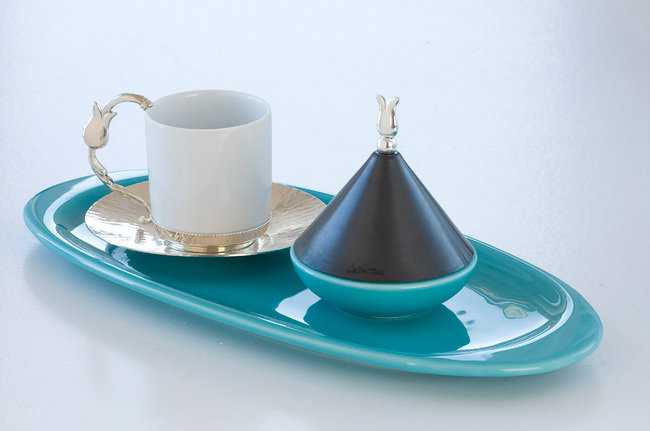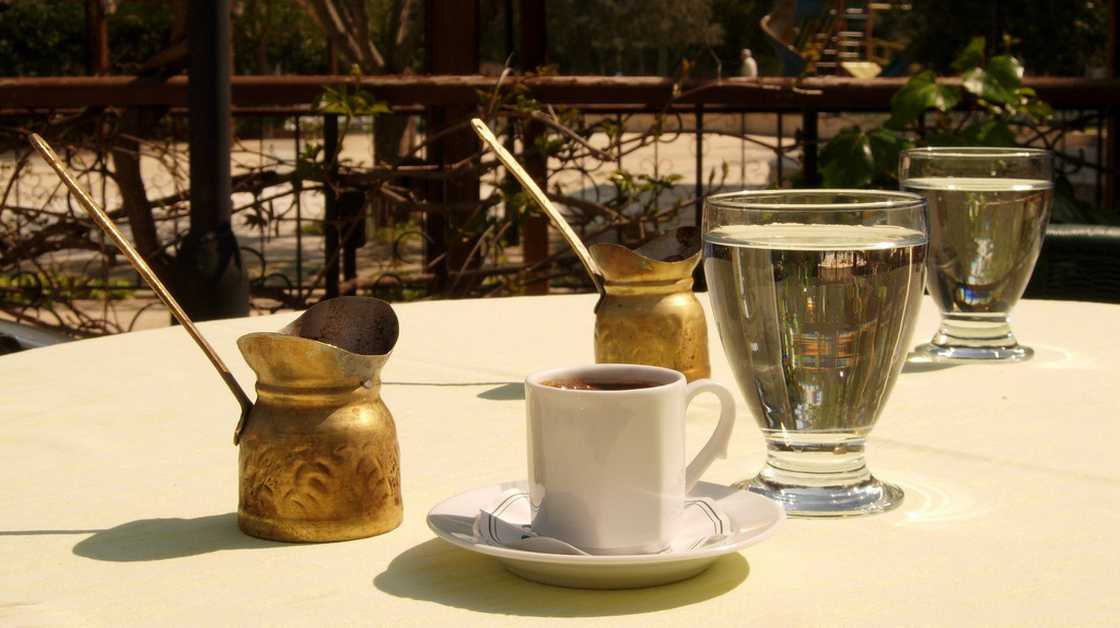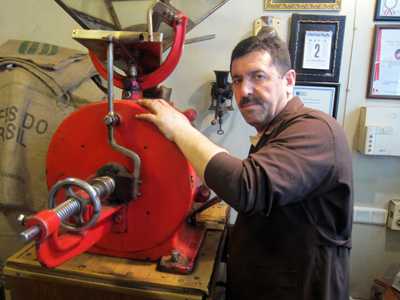Deep Roots for an Istanbul Delight
By SUSANNE FOWLER

Ozlem Tuna designed this set for serving coffee and Turkish delight, or lokum.
ISTANBUL — Good things often come in small packages: dark Turkish coffee or freshly brewed tea, for example, served in exquisite porcelain cups or etched tulip-shaped glasses, all accompanied by a mere bite or two of lokum, the candy also known as Turkish delight.
In the designer shops of Istanbul, traditional lokum dishes, or lokumluk in Turkish, are getting a modern makeover, though one with roots stretching to the Ottoman, Seljuk and even Hittite eras.
Prices can range from 390 Turkish lira, or about $192, for the designer Ozlem Tuna’s individual platter, miniature lokumluk and demitasse set, to more than to 3,100 lira for a dish in solid silver from the workshops of the upscale design house Armaggan.
“Presentation says a lot here in Turkey,” the designer Irem Bonfil of Dot Design Studio said. “It’s a sort of ceremony, so you have not just the special glass teacups, but other things you need for the table. A lokumluk is part of that.”
The serving of lokum, she said, “is a very old custom that is still used in most houses. You always have a box of lokum to put into a special dish in case someone just drops in.”
Whether the sweets are rose-scented lokum from the classic Haci Bekir on Istiklal Caddesi in the heart of the lively Beyoglu district, or rolls of almond paste from Meshur Bebek Badem Ezmesi along the Bosporus, they are presented in containers of silver, gold plate or fine ceramic decorated with accents like turquoise stones or a tulip-shaped finial.
“When I got married, I received one as a wedding gift from my mother-in-law,” Ms. Bonfil said. “It’s an important item that you receive as a young girl, and you keep it.”
Many of the lokumluk that she and others are creating are made by hand, from natural materials, by master craftsmen in the workshops that stretch from the Egyptian spice market up the hill to the Grand Bazaar.
“I had been an interior designer since 1986 for more commercial projects like large hotels and hospitals in the Middle East and Central Asia,” said Ms. Bonfil, who studied costume and stage design at the Academy of Fine Arts in Vienna. “But I wanted to come closer to local people and the source. I like to work with the craftsmen. They tell me their abilities and I design new things for them to make. It’s actually a dialog between them and me.”
Her newest line will be available, starting this month, at the Beymen department store at the new Zorlu Center Mall in Istanbul. Items include substantial plates carved from blocks of white or dark gray Turkish marble, with a small hand-hammered antique or silver-plated brass, crescent-moon-topped lokumluk as a centerpiece.
Perhaps her most interesting lokumluk reflects Ms. Bonfil’s own multicultural background.
“My mom is Levantine — half-Italian half-Hungarian — my dad is Turkish with some drops of Greek blood,” she said, “whereas my husband is a Sephardic Jew. I find myself immersed in all of these different traditions and I love it.”
That love is embodied in a 24-karat gold-plated hammered oxidized brass platter, 32 centimeters, or 12.6 inches, wide. The decorative top is a dreidel, or spinning top, crafted by Afghan Jews, she said. Some of the dreidels are engraved with Hebrew lettering. The silver and gold leaf veneer is circled with small agates and an accent bead is built from tiny pieces of turquoise. It sells for about 1,500 lira.
“I work with craftsmen whose work may be extinct soon,” she said. “There are only a few people that work on copper and brass the way you can see on my objects.”
Keeping crafts alive is also a goal of Ms. Tuna, who has a bachelor’s degree in ceramics from Marmara University.
“I work mostly with the traditional craftsmen around the Grand Bazaar,” she said. “I really care about using local products. All of my things are produced in Istanbul by hand in small ateliers using methods that haven’t changed since the Ottoman Empire.”
Ms. Tuna’s lokumluk blend old-style manufacturing with contemporary shapes and colors, offering bright turquoise or cherry red ceramics and hammered copper or brass silver-plated saucers, and cup handles with a tiny tulip motif. A set of three gold-plated, hand-beaten copper lokum bowls, called Dun, Bugun, Yarin (Yesterday, Today, Tomorrow), sells for 710 lira.
“For me, it’s very important to keep tradition alive,” she said. And that includes the role of Turkish delight in entertaining.
“Lokum is special,” Ms. Tuna said, “because Turkish coffee has a bitter taste, and we also like to eat sweets. Lokum is small and comes in different flavors. So it’s a perfect team.”
A version of this article appears in print on November 19, 2013, in The International New York Times.


